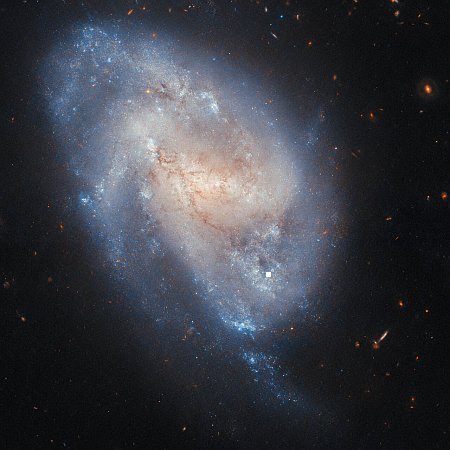Using Hubble to monitor a fading supernova
Cool image time! The picture to the right, cropped, reduced, and sharpened to post here, was taken by the Hubble Space Telescope as part of a monitoring program of the fading supernova that occurred in this galaxy in 2014, 60 million light years away. I have added a white dot to indicate the approximate location [pdf] of that supernova, as it is now too dim to see clearly in the original image. From the caption:
Researchers have determined that SN 2014cx was a Type IIP supernova. The “Type II” classification means that the exploding star was a supergiant at least eight times as massive as the Sun. The “P” stands for plateau, meaning that after the light from the supernova began to fade, the level reached a plateau, remaining at the same brightness for several weeks or months before fading further. This type of supernova occurs when a massive star can no longer produce enough energy in its core to stave off the crushing pressure of gravity. SN 2014cx’s progenitor star is estimated to have been ten times more massive than the Sun and hundreds of times as wide. Though it has long since dimmed from its initial brilliance, researchers are still keeping tabs on this exploded star, not least through the Hubble observing programme which produced this image.
The blue regions in the galaxy’s periphery suggest younger stars, while the gold color in the interior suggests an older population.
On Christmas Eve 1968 three Americans became the first humans to visit another world. What they did to celebrate was unexpected and profound, and will be remembered throughout all human history. Genesis: the Story of Apollo 8, Robert Zimmerman's classic history of humanity's first journey to another world, tells that story, and it is now available as both an ebook and an audiobook, both with a foreword by Valerie Anders and a new introduction by Robert Zimmerman.
The print edition can be purchased at Amazon or from any other book seller. If you want an autographed copy the price is $60 for the hardback and $45 for the paperback, plus $8 shipping for each. Go here for purchasing details. The ebook is available everywhere for $5.99 (before discount) at amazon, or direct from my ebook publisher, ebookit. If you buy it from ebookit you don't support the big tech companies and the author gets a bigger cut much sooner.
The audiobook is also available at all these vendors, and is also free with a 30-day trial membership to Audible.
"Not simply about one mission, [Genesis] is also the history of America's quest for the moon... Zimmerman has done a masterful job of tying disparate events together into a solid account of one of America's greatest human triumphs."--San Antonio Express-News
Cool image time! The picture to the right, cropped, reduced, and sharpened to post here, was taken by the Hubble Space Telescope as part of a monitoring program of the fading supernova that occurred in this galaxy in 2014, 60 million light years away. I have added a white dot to indicate the approximate location [pdf] of that supernova, as it is now too dim to see clearly in the original image. From the caption:
Researchers have determined that SN 2014cx was a Type IIP supernova. The “Type II” classification means that the exploding star was a supergiant at least eight times as massive as the Sun. The “P” stands for plateau, meaning that after the light from the supernova began to fade, the level reached a plateau, remaining at the same brightness for several weeks or months before fading further. This type of supernova occurs when a massive star can no longer produce enough energy in its core to stave off the crushing pressure of gravity. SN 2014cx’s progenitor star is estimated to have been ten times more massive than the Sun and hundreds of times as wide. Though it has long since dimmed from its initial brilliance, researchers are still keeping tabs on this exploded star, not least through the Hubble observing programme which produced this image.
The blue regions in the galaxy’s periphery suggest younger stars, while the gold color in the interior suggests an older population.
On Christmas Eve 1968 three Americans became the first humans to visit another world. What they did to celebrate was unexpected and profound, and will be remembered throughout all human history. Genesis: the Story of Apollo 8, Robert Zimmerman's classic history of humanity's first journey to another world, tells that story, and it is now available as both an ebook and an audiobook, both with a foreword by Valerie Anders and a new introduction by Robert Zimmerman.
The print edition can be purchased at Amazon or from any other book seller. If you want an autographed copy the price is $60 for the hardback and $45 for the paperback, plus $8 shipping for each. Go here for purchasing details. The ebook is available everywhere for $5.99 (before discount) at amazon, or direct from my ebook publisher, ebookit. If you buy it from ebookit you don't support the big tech companies and the author gets a bigger cut much sooner.
The audiobook is also available at all these vendors, and is also free with a 30-day trial membership to Audible.
"Not simply about one mission, [Genesis] is also the history of America's quest for the moon... Zimmerman has done a masterful job of tying disparate events together into a solid account of one of America's greatest human triumphs."--San Antonio Express-News



“This” galaxy’s name—according to Wikipedia—is NGC 337.